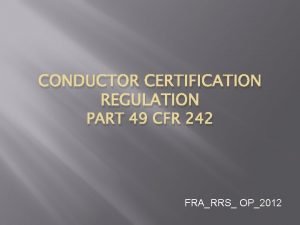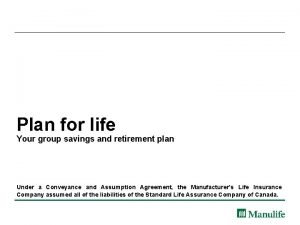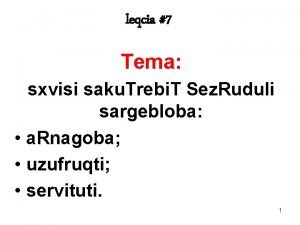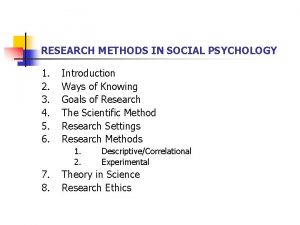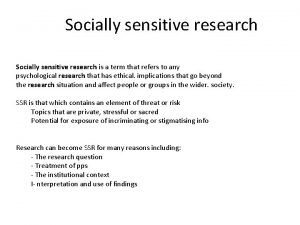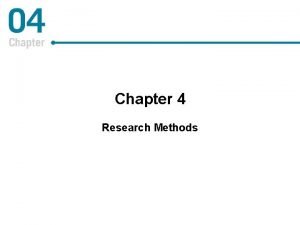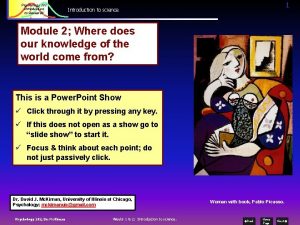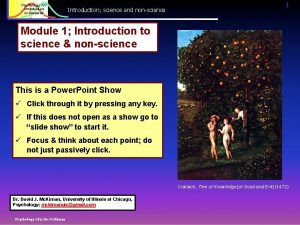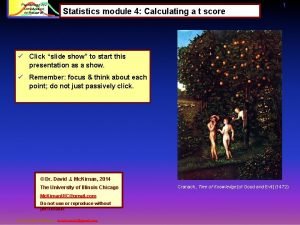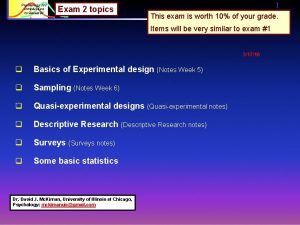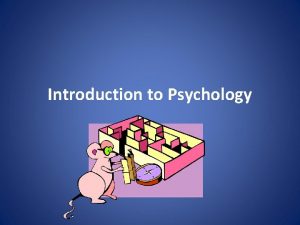Psychology 242 Introduction to Research 1 Psychology 242















































- Slides: 47

Psychology 242 Introduction to Research 1 Psychology 242, Dr. Mc. Kirnan Complex experiments: Within- subjects & blocking designs q Own control q Reversal designs q Repeated measures & Randomized block designs Third Exam: Wednesday, Dec. 2, during. 11/22/11 Psychology 242, Dr. Mc. Kirnan Within Subjects Designs

Psychology 242 Introduction to Research Basic forms of within-subjects designs, 1 Basic forms of within subjects designs; 1. Own control § Each participant in control and experimental group. § Optimally, order is counter-balanced 2. Reversal designs 3. Repeated measures & Randomized block designs Psychology 242, Dr. Mc. Kirnan Within Subjects Designs 2

Psychology 242 Introduction to Research Basic forms of within-subjects designs, 3 Basic forms of Within subjects designs; 1. Own control 2. Reversal designs § Hypothesis: behavior controlled by clearly bounded condition § Design: “A – B – A”; impose – withdraw – impose condition 3. Repeated measures & Randomized block designs Psychology 242, Dr. Mc. Kirnan Within Subjects Designs 3

Psychology 242 Introduction to Research Basic forms of within-subjects designs, 2 Basic forms of Within subjects designs; 1. Own control 2. Reversal designs 3. Repeated measures n Multiple treatment conditions: each participant gets each treatment. n Longitudinal / time sampling: each participant assessed over multiple time periods n Randomized block designs; Repeated measure combined with between-groups variable. Psychology 242, Dr. Mc. Kirnan Within Subjects Designs 4

Psychology 242 Introduction to Research Psychology 242, Dr. Mc. Kirnan Complex experiments “Own Control” designs q § Each participant is in the control and experimental group. § Optimally, order is counter-balanced q Reversal designs q Repeated measures & Randomized block designs Psychology 242, Dr. Mc. Kirnan Within Subjects Designs 5

Psychology 242 Introduction to Research Basic experiments: “Between. Subjects” designs Group 1 Experimental condition /Treatment Observe 6 Between-subjects designs Group 2 2 separate groups: Observed (naturally occurring) or Randomly Assigned to be equivalent Control condition 1 Observe 2 Independent Variable: Dependent Variable(s): One group receives the experimental condition or treatment, one does not. Measured in both groups. ü Clear experimental manipulation; treatment given to only one group. ü Hypothesis tested by differences between groups. ü Internal validity: groups must differ only on Independent variable; non-equivalence at baseline = confound ü Statistical power requires large number of subjects. Psychology 242, Dr. Mc. Kirnan Within Subjects Designs

Psychology 242 Introduction to Research Why do “Within – Subjects” designs? n n n Within Ss designs Many research questions address contrasts between different states within one person n Alcohol v. non-alcohol use aggression, risk n Learning condition v. recall state “State dependent learning” Many studies address change over time n Behavioral or biomedical intervention studies n “Natural history” or cohort studies Practical efficiency of within Ss designs n n Powerful contrasts within a participant; less within-group (error) variance. Studies that require rare or costly participants. Psychology 242, Dr. Mc. Kirnan Within Subjects Designs 7

8 Pre- Post- designs Psychology 242 Introduction to Research Non-experimental within-subjects approach Single Group Experimental Manipulation Baseline (Observe 1) All participants are assessed at baseline Single Group Assess smoking rate Psychology 242, Dr. Mc. Kirnan Follow-up (Observe 2) All participants then get the Experimental intervention and follow-up measurement. 10 -week smoking cessation program Within Subjects Designs Follow-up smoking rate

Psychology 242 Introduction to Research Single Group 9 Pre- Post- designs Experimental Manipulation Baseline (Observe 1) All participants are assessed at baseline Follow-up (Observe 2) All participants then get the Experimental intervention and follow-up measurement. ü Hypothesis is tested by change from baseline ü This is a main effect analysis ü “Groups” = baseline v. follow-up scores ü Possible confounds? ü History ü Maturation ü Regression… Psychology 242, Dr. Mc. Kirnan Within Subjects Designs

10 “Own Control” Psychology 242 Introduction to Research True experiment within-subjects design Single Group Control Condition Observe 1 All participants get the Control condition and measurement Single Group Learning under quiet conditions Psychology 242, Dr. Mc. Kirnan Recall task Within Subjects Designs Experimental Condition Observe 2 All participants then get the Experimental intervention and measurement. Learning under ‘white noise’ condition Recall task

Psychology 242 Introduction to Research Single Group 11 “Own Control” Control Condition Observe 1 Experimental Condition Observe 2 ü Each participant is his own “control group” ü Hypothesis tested by differences between conditions (Observation 1 v. Observation 2) within group. ü Internal validity: eliminate possible confound of group differences at baseline, since there is only one group. ü Experimental manipulation potentially less clear due to possible carry-over effects. ü Statistical power increased: requires fewer subjects. Psychology 242, Dr. Mc. Kirnan Within Subjects Designs

Psychology 242 Introduction to Research Own Control design with counter-balancing Group 1 Control Condition Observe 1 Experimental Condition Observe 2 Group 2 Experimental Condition Observe 1 Control Condition Observe 2 2 groups, naturally occurring or randomly assigned Basic own-control design done twice. Group 1 Learning under quiet conditions Recall task Learning under ‘white noise’ condition Recall task Group 2 Learning under ‘white noise’ condition Recall task Learning under quiet conditions Recall task Psychology 242, Dr. Mc. Kirnan Within Subjects Designs 12

Psychology 242 Introduction to Research 13 Own Control design with counter-balancing Group 1 Control Condition Observe 1 Experimental Condition Observe 2 Group 2 Experimental Condition Observe 1 Control Condition Observe 2 Own-control design done twice. ü Test the Hypothesis: by combining the 2 groups. ü Internal validity: Ø eliminate confound of group differences at baseline. Ø Lessens (& allows for test of) carry-over effects ü Statistical power design requires more subjects. Psychology 242, Dr. Mc. Kirnan Within Subjects Designs

Psychology 242 Introduction to Research Survey example of own-control design 14 Phenomenon: Treatments for HIV lower the amount of virus in the blood (“viral load”), which may make the person less infectious. Hypotheses: 1. Gay men decide how risky an HIV-infected partner is based on whether the partner has a low viral load. 2. Men who are particularly risk-prone are more likely to decide someone is “safe” via viral load information. Vanable, P. V. , Ostrow, D. G. , Mc. Kirnan, D. J. , Tayawaditep, J. , & Hope, B. A. (2000). Impact of combination therapies on HIV risk perceptions and sexual risk among HIV-positive and HIV-negative gay and bisexual men. Health Psychology, 19(2), 1 -12. Psychology 242, Dr. Mc. Kirnan Within Subjects Designs

Psychology 242 Introduction to Research Design: Community survey of Chicago MSMs 15 IV# 1; Repeated measure: hypothetical partner – The participant reads about each of 2 potential partners: An HIV+ man who is not in treatment An HIV+ men in treatment, with a low viral load – Then rates how risky each partner might be. True independent variable; manipulated by the experimenter. IV #2; Blocking variable: participants’ risk status – Participants describe their history of sexual risk and are categorized by the experimenter as ‘high’ v. ‘low’ risk Measured “blocking” variable only. Psychology 242, Dr. Mc. Kirnan Within Subjects Designs

Psychology 242 Introduction to Research 16 Mixed Repeated Measures: data structure Repeated measure: All participants respond to both conditions. Blocking variable: Men “assigned” to high v. low risk groups based on their interview answers. Sexual partner scenario Participant risk background HIV+ man who is in treatment, with a low viral load HIV+ man who is not in treatment Low risk 2, 3, 11, 5, 9, 12, 13, 16… n = 488 High risk 1, 4, 6, 7, 8, 10, 14, 15… n = 66 Subject # 1 2 3 4 5 6 7 8 9 10 11 12 13 14 15 16 Risk level H L L H H H L H Psychology 242, Dr. Mc. Kirnan Within Subjects Designs L L L H H L

Psychology 242 Introduction to Research Survey: repeated & blocked analyses, 4 17 Data: A statistical interaction between the repeated measure and the blocking variable. Vanable, P. V. , Ostrow, D. G. , Mc. Kirnan, D. J. , Tayawaditep, J. , & Hope, B. A. (2000). Impact of combination therapies on HIV risk perceptions and sexual risk among HIV-positive and HIV-negative gay and bisexual men. Health Psychology, 19(2), 1 -12. Psychology 242, Dr. Mc. Kirnan Within Subjects Designs

Psychology 242 Introduction to Research Survey: repeated & blocked analyses, 5 Data: Both risk groups consider an HIV+ partner with low viral load to be safer “Low” viral load information lowers risk perception most for the risky men. Giving all participants both conditions creates a strong contrast (Independent Var. ). Psychology 242, Dr. Mc. Kirnan Within Subjects Designs 18

Psychology 242 Introduction to Research n n Participant assignment problems eliminated, since there is only one group. n No need for random assignment or matching procedures n No possible problem with groups differing at baseline. Can use a smaller n than between S’s n n n Advantages of own-control designs 19 Half as many participants for simple own-control experiment Very useful for rare or expensive participants More sensitive to experimental effects; less withinsubject (error) variance Psychology 242, Dr. Mc. Kirnan Within Subjects Designs

Psychology 242 Introduction to Research n Sequencing or order effects: n n n Scores change if participants learn or get practice over different conditions Participants get sensitized to experiment or experimental procedures Cure by counter-balancing order of condition. n n Disadvantages of own-control designs Takes as many participants as between - group design Participant “burden” n Fatigue from multiple experimental tasks n Possible drop-out Psychology 242, Dr. Mc. Kirnan Within Subjects Designs 20

Psychology 242 Introduction to Research Psychology 242, Dr. Mc. Kirnan Complex experiments q Own control Reversal designs q § Hypothesis: behavior is controlled by a clearly bounded condition § Design: “A – B – A”; impose – withdraw – impose condition q Repeated measures & Randomized block designs Psychology 242, Dr. Mc. Kirnan Within Subjects Designs 21

Psychology 242 Introduction to Research Basic Reversal design structure “Normal” baseline state Measurement or testing Impose temporary experimental condition Measurement or testing Return to normal state Measurement or testing Examples: n Role of incentives in enhancing performance n Impact of anti-depressant drug on mood n Effect of self-awareness on following social norms Psychology 242, Dr. Mc. Kirnan Within Subjects Designs 22

Core Assumptions of reversal designs: Psychology 242 Introduction to Research Clear stimulus or condition -related hypothesis n n Hypothesize that behavior is directly tied to a condition or stimulus Clear beginning and ending § No “carry-over” effects (due to, e. g. , learning, sensitization, etc. ) § Changes in behavior only last as long as condition is in place § Changes can be induced and reversed more than once Psychology 242, Dr. Mc. Kirnan Within Subjects Designs 23

Psychology 242 Introduction to Research 24 Examples of reversal designs Test effect of, e. g. , modeling (observation of attractive experimental confederate) on alcohol consumption. If the model influences Participant’s drinking rate participant’s behavior: Psychology 242, Dr. Mc. Kirnan n Within Subjects Designs Consumption will increase when the model’s does… Rate goes back down when model’s does. Up again with model, etc. .

Psychology 242 Introduction to Research 25 Reversal designs & carry-over Reversal designs can test carry-over effects: Reversal effect: Modeling controls drinking rate Psychology 242, Dr. Mc. Kirnan Within Subjects Designs Carry-over effect: Drinking rate gradually increases over time no matter what.

Psychology 242 Introduction to Research Example: single group study with reversal design The Hawthorne Study. 26 The Hawthorne Study is one of the more… ü Famous, ü Misunderstood & misused. social research studies ever conducted Context: § Hawthorne Electrical Plant (Hawthorne Il. ) § 1950 s era ü Strong political fears of “Communist conspiracy” ü Unions seen as ‘fronts’ for international Communism. § Working conditions terrible at Hawthorne, as in many companies. ü OSHA did not exist; worker’s rights largely absent § Many Social Psychologists were imbued with the conservative (anti-union) tenor of the times.

Psychology 242 Introduction to Research Single group reversal design: The Hawthorne Study Context (cont. ): § Union drive taking place ü Demands for better working conditions § Productivity & quality decreasing Study Purpose 27 Pre-Intervention Baseline assessment 1 st Intervention (change lighting) § Increase motivation & productivity. Hypothesis § Employees simply want attention § Any change in the work environment - even a trivial one - leads to change. Intervention § Change inadequate lighting. Study structure: Reversal design 1 st Follow-up assessment 2 nd Intervention (Reversal; change the lighting back) 2 nd Follow-up assessment

Psychology 242 Introduction to Research Single group reversal design: The Hawthorne Study Outcomes § Daily assembly line output Findings § Output rises after lighting improved (1 st follow-up). § Output rises again after lighting reversed to initial state. § Thus: ü Any change, even a negative one, “motivates” workers. . ü Workers respond to simple attention, not real change. Internal validity? § Political bias: researchers hired to disprove workers’ claims! § Mortality: as part of “union busting” dissatisfied workers fired during study period. § Reactive measures: workers fear for job may increase production, not workplace change. Sad legacy of the Hawthorne study § The “Hawthorne effect” is commonly cited to discount demands for change, or explain away positive findings of interventions. 28

Psychology 242 Introduction to Research Psychology 242, Dr. Mc. Kirnan Complex experiments q “Own Control” designs q Reversal designs Repeated measures & q Randomized block designs § Combine a blocking or grouping variable with a repeated measure. § Most common Within-Subjects design § § Psychology 242, Dr. Mc. Kirnan Biomedical research Behavioral intervention evaluation 29

Psychology 242 Introduction to Research 30 Simple repeated measures / time series designs Group Measure 1 M 2 M 3 M 4 M 5 M 6 … Group 2 Measure 1 M 2 M 3 M 4 M 5 M 6 … Group 3 Measure 1 M 2 M 3 M 4 M 5 M 6 … n n n Examine / describe changes over time in one or more key variables. Describe or test hypotheses about group differences over time. Groups may be assigned, in a true experiment. § … intervention groups with long-term follow-up § Groups may be measured or naturally occurring. § … age, gender or ethnic groups. n Longer time-frame yields more valid & interpretable data.

Psychology 242 Introduction to Research Is attention to childhood obesity causing it to decease? 2003 2012 data § Older kids (2 19): no change § Toddlers appear EXAMPLE to be doing better. § Supports effectiveness of recent infant programs. Longer time frame: 1999 2012 § Older kids no still show no change § Toddlers only look better because of a spike in 2003. § Looking back to 1999 shows a flat line with lots of variance. 31

Psychology 242 Introduction to Research Group Interrupted time series design Measure 1 M 2 M 3 M 4 M 5 M 6 … Intervention or event n n Test effect of intervention or event on ongoing series of measurements. Intervention may be experimental or observed § Policy shift, e. g. , educational policy § Uncontrolled event; e. g. , 9/11/01, Media event § Assessments may be experimental or archival § Successive cross-sectional surveys § Traffic data, clinic or crime reports, test scores Psychology 242, Dr. Mc. Kirnan 32

Psychology 242 Introduction to Research Group Measure 1 M 2 Multiple baseline n n 33 Time series designs Demonstrate highly stable effect long-term crime rates disease prevalence economic performance… Show steady rate of change Psychology 242, Dr. Mc. Kirnan M 3 M 4 M 5 M 6 … Intervention or event Hypothesis; tested by: n n Shift in stable rate after intervention Increase / decrease in rate of change after intervention

Psychology 242 Introduction to Research Example of interrupted time series: Shift culture. in Baboon EXAMPLE Core question: Do baboon troops develop and transmit a learned “culture”? Baseline: Long-term observational data on aggressiveness in a specific baboon troop. Intervention: ü Tuberculosis outbreak due to infected food. ü Dominant / aggressive males fed first ü ü are selectively infected ü are naturally culled from troop Naturally occurring event in >20 yr. ongoing field study: Long repeated measures / time series. Psychology 242, Dr. Mc. Kirnan 34

Psychology 242 Introduction to Research Baboon culture: findings 35 Quasi-controls: Parallel data from other baboon troops. Core finding: EXAMPLE ü With dominant males gone, remaining males showed more cooperative behavior ü Enhanced cooperation was transmitted across generation, showing learned “culture”. Major virtue of repeated measures: ü Finding made possible by many assessments over considerable time Psychology 242, Dr. Mc. Kirnan

Psychology 242 Introduction to Research Randomized block designs Blocking Variable; between - subjects factor n “Person” variable; age, gender, ethnicity, etc. n Not a “true” IV since people not randomly assigned; Or: n Experimental condition; drug dose, treatment, etc. n “True” IV with random assignment Repeated measure: within-subjects factor n Multiple treatment conditions: each participant is observed in each treatment condition n (e. g. , high v. low drug dose, different instructions…) Or: n Longitudinal / time sampling: measure D. V. over multiple time periods (Cohort studies) 36

Psychology 242 Introduction to Research 37 Within subjects designs; own control, 3 Repeated measures / randomized block design Group 1 Baseline Measure Control Condition Measure 2 M 3 M 4. . Group 2 Baseline Measure Experimental Condition Measure 2 M 3 M 4. . Assignment Randomly or via natural “blocks” Treatment. Primary Independent Variable. Control group may receive Placebo. Baseline assessment prior to intervention or experimental condition. Psychology 242, Dr. Mc. Kirnan Within Subjects Designs Follow-up. Long-term assessment of outcome or Dependent Variable. Time may represent 2 nd Independent Variable.

Psychology 242 Introduction to Research Example of Repeated Measure Design 38 Question: Do Gay / bisexual men who use HIV medications as Post-Exposure Prophylaxis [PEP] have more risky sex. Independent variables: Medication use: Between subjects / Measured “blocking” variable: men who request PEP v. those who do not. Study visit [time]: Repeated Measure [within subjects]: Participants are interviewed every 6 months. Dependent variable: % of men reporting risky sex at any given time period. Psychology 242, Dr. Mc. Kirnan Within Subjects Designs

Participants reporting (%) Psychology 242 Introduction to Research 39 Unprotected anal intercourse (UAI) with HIV positive and unknown sero-status partners among MSM, by study visit Blocking variable All men get safer over time (a Main Effect) Month of study visit *Adjusted for age, study site, drug use, Within and Subjects education Designs Psychology 242, Dr. Mc. Kirnan Repeated Measure OR*(CI) p PEP 1. 7(1. 2 -2. 2) . 001 Visit 0. 97(. 96 -. 99). 001

Participants reporting (%) Psychology 242 Introduction to Research 40 Unprotected anal intercourse (UAI) with HIV positive and unknown sero-status partners among MSM, by study visit Blocking variable Non-users of PEP are generally safer (also a Main Effect) Month of study visit *Adjusted for age, study site, drug use, Within and Subjects education Designs Psychology 242, Dr. Mc. Kirnan OR*(CI) p PEP 1. 7(1. 2 -2. 2) . 001 Visit 0. 97(. 96 -. 99). 001

Participants reporting (%) Psychology 242 Introduction to Research 41 Unprotected anal intercourse (UAI) with HIV positive and unknown sero-status partners among MSM, by study visit Blocking variable Non-users at the end of the study are safest (an Additive Effect; time + group) Month of study visit *Adjusted for age, study site, drug use, Within and Subjects education Designs Psychology 242, Dr. Mc. Kirnan OR*(CI) p PEP 1. 7(1. 2 -2. 2) . 001 Visit 0. 97(. 96 -. 99). 001

Participants reporting (%) Psychology 242 Introduction to Research 42 Unprotected anal intercourse (UAI) with HIV positive and unknown sero-status partners among MSM, by study visit Blocking variable There is no Interaction Effect: The effect of time is the same for both groups. Month of study visit *Adjusted for age, study site, drug use, Within and Subjects education Designs Psychology 242, Dr. Mc. Kirnan OR*(CI) p PEP 1. 7(1. 2 -2. 2) . 001 Visit 0. 97(. 96 -. 99). 001

Hypothetical Example ofblock a design, randomized block randomized 1 design; basic clinical intervention / drug trial Psychology 242 Introduction to Research 43 Question: Effectiveness of different doses of an anti -hypertensive drug 2 nd questions: Effects of: time, gender, medical status of patients. Population: Hypertensive patients [systolic Bp > 145] Outcome [D. V. ] Systolic Blood pressure Blocking variable: Drug dose: placebo v. 2 doses (high / low). This IV carries the main hypothesis. Repeated Measure: Time. Key element of effectiveness: stability x follow-up. 2 nd Blocking vars. : Gender, medical status, ethnicity, etc. Psychology 242, Dr. Mc. Kirnan Within Subjects Designs

Psychology 242 Introduction to Research 44 Hypothetical randomized block design, 3 Systolic blood pressure Example # 1 (hypothetical data): drug dose & time on systolic Bp, complete sample Psychology 242, Dr. Mc. Kirnan What does this pattern of data show? n Main effects? n Interaction effects? n Within Subjects Designs Hypothesis supported?

Psychology 242 Introduction to Research 45 Hypothetical randomized block design, 4 Systolic blood pressure Example # 2, hypothetical data: drug dose & time on systolic Bp, complete sample Psychology 242, Dr. Mc. Kirnan What does this pattern of data show? n Main effects? n Interactions? n Within Subjects Designs Hypothesis supported?

Psychology 242 Introduction to Research 46 Hypothetical randomized block design, 5 Systolic blood pressure Example # 3, hypothetical data: drug dose & time on systolic Bp, complete sample Psychology 242, Dr. Mc. Kirnan Within Subjects Designs n Main effects? n Interactions? n Hypothesis?

Psychology 242 Introduction to Research n Within subjects designs somewhat common in psychological research; n n n Summary Own control designs: create strong contrast for IV Eliminate problems in creating experimental v. control groups. Very common in bio-medical or public health studies; n n n Most clinical studies are longitudinal; participants followed over time Intervention or experimental treatment is I. V. #1 (blocking or grouping variable). Stability over time is I. V. # 2 (repeated measure) Psychology 242, Dr. Mc. Kirnan Within Subjects Designs 47
 Lagu muliakan allah bapa
Lagu muliakan allah bapa Gezang 242
Gezang 242 49 cfr 242
49 cfr 242 Eu confio firmemente
Eu confio firmemente Carrsh
Carrsh Csc 242
Csc 242 Et 242
Et 242 Algol typing discipline
Algol typing discipline Manulife vip room withdrawal
Manulife vip room withdrawal Sxvisi saxli
Sxvisi saxli Step ap 242
Step ap 242 Et 242
Et 242 Schema 242
Schema 242 Me 242
Me 242 I^242
I^242 Is-242.b
Is-242.b Series parallel resonance
Series parallel resonance Positive psychology ap psychology definition
Positive psychology ap psychology definition Psychology experiment
Psychology experiment Social psychology ap psychology
Social psychology ap psychology Applied psychology vs psychology
Applied psychology vs psychology Social psychology is the scientific study of:
Social psychology is the scientific study of: Health psychology definition ap psychology
Health psychology definition ap psychology Ap psychology unit 1 test
Ap psychology unit 1 test Method of social psychology
Method of social psychology Correlational research psychology
Correlational research psychology Research methods in developmental psychology
Research methods in developmental psychology Research design in clinical psychology
Research design in clinical psychology Pertanyaan sulit tentang perilaku konsumen
Pertanyaan sulit tentang perilaku konsumen Sential
Sential Experimental psychology research topics
Experimental psychology research topics Socially sensitive research meaning
Socially sensitive research meaning Research methods in abnormal psychology
Research methods in abnormal psychology Ocr psychology research methods
Ocr psychology research methods Module 7 research design and ethics in psychology
Module 7 research design and ethics in psychology Subfields of psychology
Subfields of psychology Goals of psychological enterprise
Goals of psychological enterprise Psychology research methods worksheet answers
Psychology research methods worksheet answers Disinhibition
Disinhibition Research enterprise in psychology
Research enterprise in psychology Research report vs research proposal
Research report vs research proposal Methodology vs. method
Methodology vs. method Appendix sample
Appendix sample Conclusive research example
Conclusive research example Applied research means
Applied research means Theoretical background example
Theoretical background example Contrast applied research and basic research
Contrast applied research and basic research Sources of research problem
Sources of research problem


